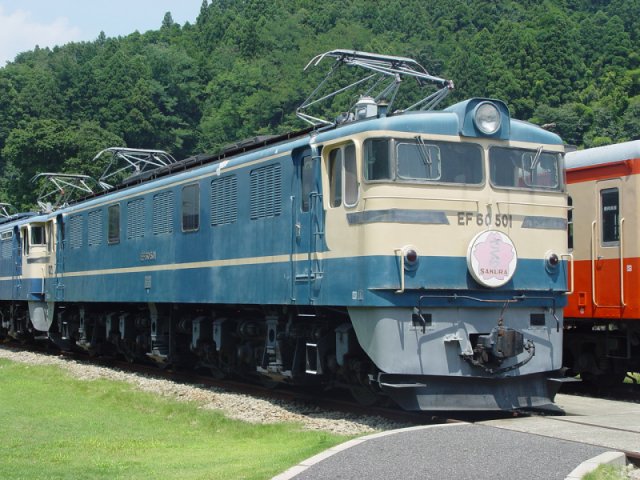- JNR Class EF60
Infobox Locomotive
name=EF60
electricsystem=1,500 V DC
tractionmotors=DC
powertype=Electric

caption=EF60 501 preserved at the Usui Pass Railway Heritage Museum in Yokokawa2004-08-12
builddate=1960 - 1964
builder=Kawasaki, Mitsubishi, Tōshiba, Tōyō & Kisha
weight=96 tons
uicclass=Bo-Bo-Bo
gauge=1,067 mm
firstrundate=
disposition=
numinclass=143
wheeldiameter=1,120 mm (driving wheels)
poweroutput=2,550 kW (EF60 15 onward)
wheelbase=
tractiveeffort=
topspeed=100 km/h
length=16,500 mm
width=2,800 mm
height=3,960 mm
transmission=
railroad=JNR ,JR East |The EF60 class was the first
Japan ese second-generation DCelectric locomotive type with six driven axles (classes EF60 to EF67), and the first versions used the same MT49 390 kWtraction motor s as the ED60 and ED61 designs. A total of 143 locomotives were built between 1960 and 1964 by Kawasaki, Tōshiba, Tōyō + Kisha, andMitsubishi . The class was split between 129 freight locomotives (classified EF60-0) designed to supersede the mammoth EH10s on Tōkaidō and Sanyō freight, and 14 passenger locomotives (EF60-500) to replace EF58s on sleeping car trains on the Tōkaidō and Sanyō Mainlines.The third-batch build of locos (EF60 84 to 129 and EF60 512 to 514) had up-rated traction motors and differed slightly in having twin headlamps (like the EF65 and other later types) rather than the single large headlamp on earlier versions. Unlike the ED60s, these locos were designed to operate singly rather than in pairs, and so cab-end gangway doors were not included. The EF60-0s initially appeared in the standard all-over brown livery, but were repainted into blue from 1965 onward.
The role of the EF60-500s at the head of the premier Blue Trains was short-lived, however, with the arrival of more powerful EF65s in 1965, and they too found themselves transferred to freight duties. From the late 1970s, EF60s were to be seen on the Chūō, Takasaki, and Ryōmō Lines in the Kantō region, and some locos were transferred to the Hanwa Line and Kisei Mainline in the
Kansai region from the mid-1980s.Withdrawals commenced in the 1980s, and all members of the class were withdrawn from regular operations in 1986, ahead of privatization. Two locos survived into JR days: EF60 19 owned by
JR East for special event use, and EF60 503 byJR West .Eight early-built locos were converted to EF61-200s between 1977 and 1979 for use as bankers on the steeply-graded “Senohachi” section of the Sanyō Mainline between Seno and Hachihonmatsu. Three more later-built EF60s were more extensively rebuilt in 1982 to become EF67 class banking locos (numbers EF67 1 to 3) for use on the same section.Build details
Banker conversions
Preserved examples
* EF60 19 Preserved at JR-East Takasaki Depot in operating condition (occasional mainline use), repainted in 2007 into standard blue/cream livery (previously special white livery with blue/red stripes)
* EF60 47 No. 2 cab section only, on display inside JR-East Ōmiya Works, brown livery
* EF60 123 Plinthed in front of Ashikaga station (JR Ryōmō Line), standard blue livery
* EF60 501 Usui Pass Railway Heritage Park, near Yokokawa station, tokkyū blue livery
* EF60 503 Formerly preserved at JR-West Miyahara Depot (current status unknown)
* EF60 510 Formerly preserved at JR-East Ōmiya Works (current status unknown)Models
The EF60 is available in model form in
N gauge from Kato as both the EF60-0 and EF60-500 versions. Aoshima makes a 1/50 scale non-powered plastic kit of the EF60.References
*Kōichi Inoue, “Kokutetsu Kikansha Jiten” (JNR Locomotive Guide), Man To Man Books, 1999
----
Wikimedia Foundation. 2010.
